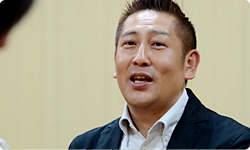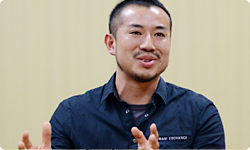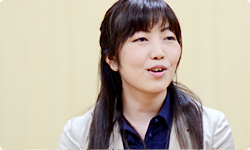So Mario & Luigi: Dream Team Bros. started. How long did it take from the beginning of development until the project was complete and ready for mass-production?
We started with the basic parts that we call the alpha version, so about one year and a half from the prototype.
This time, we divided the entire development phase into the one to create an alpha version, one for a beta version and even a gamma version, and looked back as we developed it.
A gamma version? Video games usually only have alpha and beta versions during development.
Usually, yes. (laughs) This time, we actually made the backgrounds in 3D, but all the characters are 2D pixel art. It was hard making that stereoscopic for Nintendo 3DS. That was one reason it took so long after the previous game.
What?! You mean to say that pixel artists drew each character as pixel art that would look three-dimensional?!
Yes, that’s right. (laughs) We worked out special ways of drawing and using colour to make them look three-dimensional. The workload was tremendous, but thanks to that, it has the sort of smooth polish distinctive of AlphaDream.

But the larger the character, the more the flatness of the 2D would stand out, so we had to do a lot of retakes.
Boss battles have to have impact, so we asked them to do those over and over until we were satisfied.
What an interesting way to make a game! (laughs) Why did you choose that method?
To be honest, part of it was that AlphaDream’s background is in 2D pixel art and we don’t have enough in-house personnel in 3D. This time, Luigi fights as a giant in the dream world, and when it came to 2D giant battles – and only then – we ran against our limits, so we asked another company to work on them.
Just looking at AlphaDream’s precise animation makes me feel warm inside, and thanks to rendering the characters in 2D, that is fully in effect on Nintendo 3DS, too.
While company circumstances lay behind it, it’s interesting how well it worked out, rather than posing a constraint. Nonetheless, while lots of people can do pixel art, I’ve hardly heard of anyone who could do stereoscopic pixel art! (laughs)
It was my first time, too! (laughs)
And you used pixel art for all the direction patterns for character movement?
Yes. All of them. On Nintendo DS, there were about eight directions, but for Nintendo 3DS, we made pixel art for 16 directions. What’s more, Luigi’s hat has an L on it, so we couldn’t simply mirror the data.
If you did that, the L would be backwards. (laughs)
Likewise with Mario, he always raises his left arm when jumping. Simply mirroring him was off the table because the gesture would be backwards.
How many people on the staff worked on Mario and Luigi’s animation patterns for 16 directions?
There were a lot besides Mario and Luigi, so including all the characters, we had about five or six people making them.
The volume of work makes me feel faint. (laughs)
Yeah. (laughs) One thing we paid attention to was how, depending on how we showed them, it might feel weird when lots of Luigis showed up – like when you hit an enemy with a bunch of Luiginoids stuck together into a Luiginary Ball . It could give you a chill to see a bunch of little Luigis lined up!
It felt worse the more orderly they were?
Yeah. So we changed the movement for each one and changed the poses to keep it random. If you look closely, we made sure each one is in a slightly different position and the movement of the animation is different. (laughs)

Also, Mario and Luigi rarely speak, so we have to express their emotions through their poses. The way their reactions make you laugh is incredibly well done. That’s what’s great about AlphaDream’s pixel art.
Who provided the direction for those movements?
For the most part, Otani-san and I made requests, but otherwise, the designers made them as they pleased.
And they didn’t use any pre-existing data?
No, they’re each one of a kind.
You made each one specially? Wow…that would take time! Now I understand why it took three years since the previous game. What a staggering workload! (laughs)
(laughs wryly)
But it’s in proper 3D, so it feels different than polygons, which is mysterious in a way I’ve never seen before. The more I look at it, the richer it is, thinking, “You draw it by hand…right? But even so, doesn’t it look unique? How did you make that?” You truly are a team that’s proud of what you do with pixel art.
Another thing that was hard in its own way was the process of trial and error in presenting three Luigis together: the pixel-art Luigi in the game, the polygon Luigi in the giant battle, and the Luigi sleeping in the bottom screen, which has an illustrated touch. In the end, we asked them to remake the Luigi in the bottom screen.

Yeah, we gave him a big makeover!
Luigi’s difficult even when he’s asleep. (laughs) Hmm. Still, I have to say I’ve hardly ever heard of anyone who can do stereoscopic pixel art.
(laughs)
© 2024 Nintendo.